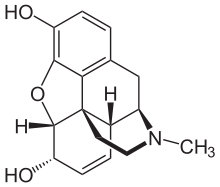
“Well it just goes to show/ Things are not what they seem/ Please, Sister Morphine/ Turn my nightmares into dreams.” — Rolling Stones
On May 18th, the journal Nature Chemical Biology published an article entitled, “An enzyme-coupled biosensor enables (S)-reticuline production in yeast from glucose.” It’s a title that would generate little interest outside of a handful of biochemists had the authors not spelled out its implications elsewhere.
(S)-reticuline is an intermediate in the biochemical pathway to morphine in opium poppies. And previously, two other yeast strains have been engineered to produce morphine from (R)-reticuline, and (R)-reticuline from (S)-reticuline. In others words, there are now three yeast strains that — working together — could produce morphine starting with glucose — no opium poppies required. They did this by splicing genes from poppies and other organisms into these strains. It is, of course, only a short matter of time until all the genes necessary are brought together into single strain.
Morphine has legal medical uses, and is also used as illegal drug. It can also be used to produce heroin. In some countries, there are legal medical uses for heroin, but the vast majority of heroin production is for sale as an illicit drug. (In the US, it is a schedule 1 narcotic and not legal for any purpose.) If a yeast strain is engineered to produce morphine from glucose, that morphine could be used as the starting point to synthesize heroin and many other popular opiates, such as codeine, or opiodes, including hydrocodone and oxycodone.
Yeast and other microorganisms already produce a wide variety of compounds for human use. As brewers, we know that brewers yeast makes the alcohol in beer, wine, and mead. Many chemicals — including ethanol, citric acid, and acetic acid — are produced by industrial fermentations. And of course, the vast majority of commercially available enzymes, and quite a few pharmaceuticals, come from fermenters. For example, if you know anyone who is diabetic, they almost certainly treat their symptoms with Humulin — human insulin produced by genetically-engineered bacteria.
So drugs have been made via fermentation before, but never an opiate. And this has a variety of people concerned. There are currently no laws against creating or possessing a genetically engineered microorganism capable of producing controlled substances. Such an organism would obviously be a huge boon to the legal pharmaceutical industry. However, it likely will not be welcomed by the (legal) opium poppy growers in Australia, not to mention the illegal opium poppy growers in Afghanistan. Given that morphine could soon be made in simple home laboratories, law enforcement agencies worry about a flood of opiates. Ironically, even large illegal drug cartels may worry about this development as morphine production could be so simple that there would be no need for their production facilities or distribution networks.
Scientists working in the field have already identified many of the likely societal problems stemming from their work and are already calling for legal reforms. Included among them are a call for scientists producing such yeast strains to additionally engineer them to have unusual growth requirements. This way, cultures that are stolen from a lab could not be grown unless the thief also knew the required details of the organism’s growth media.
So brewers yeast — that “humblest of all ‘beasts’” — will soon be able to make morphine. Already, this has led multiple sources to claim that producing morphine will possible for anyone who brews beer at home. Tomorrow, I’ll discuss why that idea is flat out wrong.
—
Related Articles

Speak Your Mind